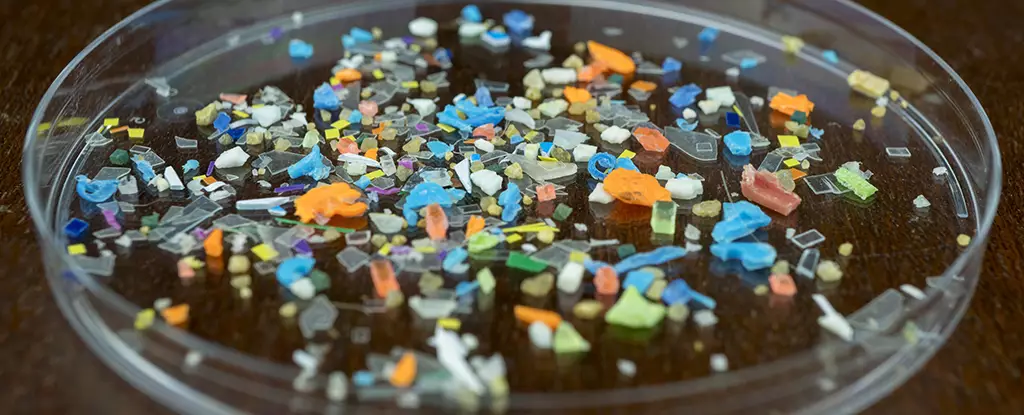In recent years, the conversation surrounding microplastics has grown louder, with mounting evidence of their omnipresence in our environment. From oceans to the food supply, these minuscule particles are infiltrating every facet of life, including our bodies. While their presence is now a well-known fact, the question of their impact on human health remains unsettlingly ambiguous. Recent studies, particularly one conducted by researchers at National Cheng Kung University in Taiwan, have unearthed alarming insights on how nanoplastics specifically affect gut health, signaling the urgent need for further investigation into this pervasive threat.
An Alarming Discovery in Animal Models
The Taiwanese study, which intricately explored the effects of polystyrene nanoplastics on mice, provides a sobering glimpse into the potential health ramifications of plastic ingestion. Mice were administered polystyrene nanoplastics at a size of merely 100 nanometers—minuscule fragments that are able to bypass bodily defenses, resembling the scale of biological processes. Over a period of 12 weeks, the resulted changes revealed disturbing alterations in gut integrity and microbiota composition. The study stands out because it illustrates how plastics are not just inert substances, but rather dynamic entities capable of engaging in biological interactions.
In this investigation, markers indicating protein production and gene activity were scrutinized, revealing a worrying decline in proteins crucial for maintaining gut barrier integrity. This deterioration could potentially pave the way for a myriad of gastrointestinal complications. Alarmingly, beneficial bacteria such as Lactobacillus took a hit, while the levels of pathogenic bacteria like Ruminococcaceae surged—a stark reminder that the balance of our gut microbiome can be easily tipped.
The Mechanisms at Play
One of the pivotal findings in the study is how nanoplastics affect the microRNA within extracellular vesicles exchanged between intestinal cells and gut microbes. This disruption suggests a loss of communication between host and microbes, potentially exacerbating gut health issues. The implications go beyond mere population shifts in bacteria; they hint at deeper molecular mechanisms that can affect how our bodies respond to environmental toxins.
Microbiologist Wei-Hsuan Hsu’s remarks about the research highlight the importance of molecular understanding in addressing health risks. The intricate interplay between nanoplastics and gut microbiota highlights a new frontier in the understanding of how environmental contaminants can influence our biology fundamentally. The research also suggests that changes in gut health could have repercussions on systemic health, potentially culminating in long-term effects that remain to be fully understood.
Translating from Mice to Humans: Caution Calls for Further Research
Despite the compelling findings, a critical caveat must be acknowledged: while mice serve as key models in biological research, they are not perfect analogues for human health. The quantity of nanoplastics administered to the rodents vastly exceeded what is generally applicable to human ingestion, creating uncertainty about the practical relevance of these results. We are left to wonder whether the levels of nanoplastics that we encounter in our daily lives are sufficient to provoke similar biological responses.
Moreover, an additional layer of complexity arises from the limitations inherent in current detection technologies, which struggle to accurately determine nanoplastic exposure in humans. Immunologist Yueh-Hsia Luo emphasizes the importance of continuous research to bridge the gap between animal models and human health outcomes. The potential for nanoplastics to contribute to chronic health issues warrants not only acute research but also long-term epidemiological studies assessing real-world exposure levels.
Rethinking Plastic in Our Lives
As the evidence mounts concerning the impacts of microplastics, it compels society to rethink our relationship with plastic products. The prevalence of plastics in our environment is an unsettling reminder of both our consumption patterns and their long-term implications. Are we contributing to our downfall by allowing such materials to dominate our ecosystems? The urgency of addressing plastic pollution cannot be overstated, and public awareness and policy initiatives may need to evolve rapidly in response to the revelations presented by studies like these.
Awareness is the first step to change, and as we delve into understanding how nanoplastics might silently alter our health, it reveals a profound need for coordinated action in environmental health, public policy, and individual lifestyle choices. The potential crisis of gut health related to microplastics is not one we can afford to ignore, making continued research imperative in safeguarding both ours and future generations’ well-being.


Leave a Reply